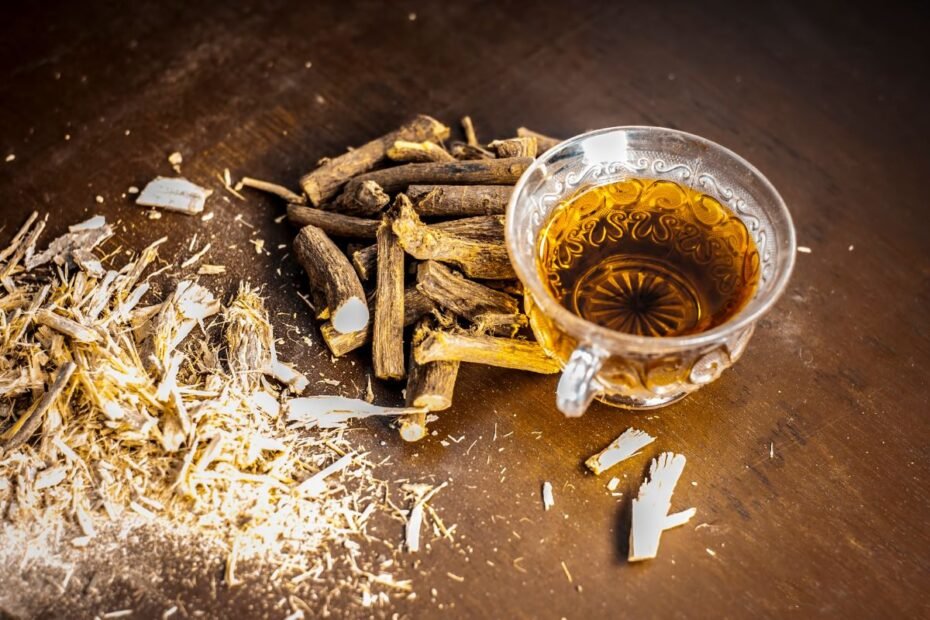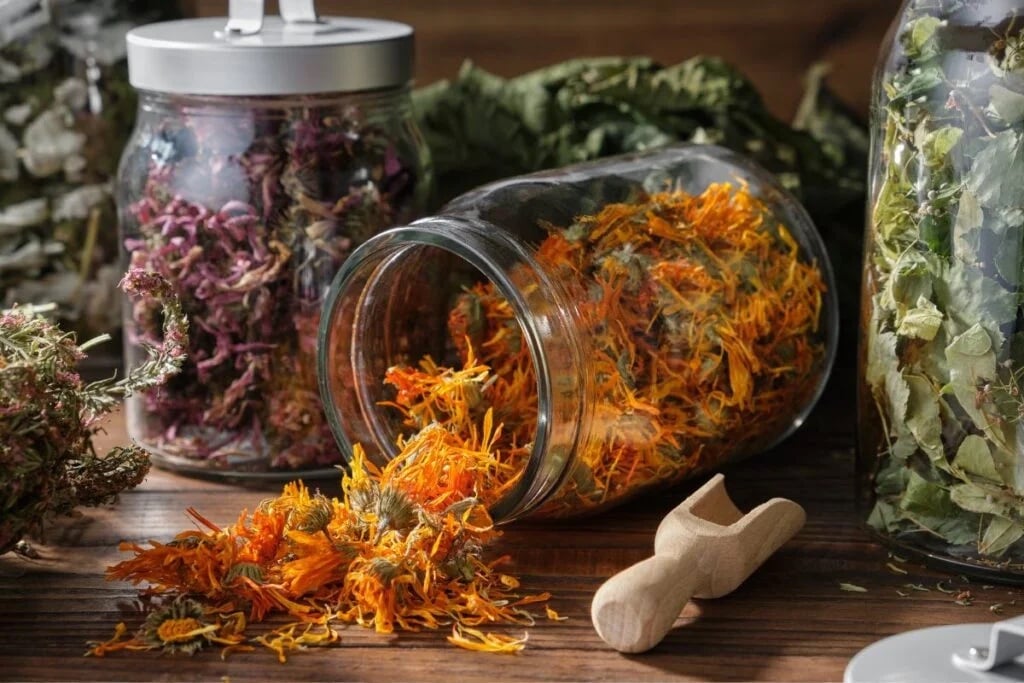Licorice root is considered one of the oldest medicinal herbs. This beverage helps treat a variety of health issues, so let’s familiarise licorice root tea benefits. Additionally, the food industry uses licorice root to produce various sweets.
Licorice (Glycyrrhiza glabra) is a legume family (Fabaceae) member and belongs to the Glycyrrhiza genus. This plant originates from Eurasia, Central and Southwest Asia, and the Mediterranean region. The numerous varieties of licorice are cultivated in Iran, Afghanistan, China, Pakistan, Iraq, Azerbaijan, Uzbekistan, Turkmenistan, and Turkey.
However, licorice can tolerate colder climates quite well, and people cultivate it. When the plant is dormant during winter, licorice accumulates nutrients for new growth in the next season.
Licorice is a perennial plant growing to about 50–80 cm. Its stem is upright and covered with short, fine hairs. The leaves are pinnate and odd-compound, while the purple flowers grow in clusters. It blooms from June to August.
Licorice Root as Raw Material
People utilize fresh or dried licorice root for food and medicinal purposes. When freshly washed, licorice root has a bright yellow-brown color skin.
Licorice root is commonly available in pharmacies or health food stores. However, if you or a friend grow licorice at home, you can prepare the raw material yourself.
Licorice roots are long and deep, so digging them up may require the right shovel and heavy physical effort. Once unearthed, carefully clean the roots, wash them under running water, peel off their outer skin, and cut them into larger pieces. Then, dry prepared roots in a warm, sunny, well-ventilated space or at 50°C in the dryer. Properly dried licorice roots should be odorless and yellow. Place and store dried licorice root in a cool, well-ventilated place.
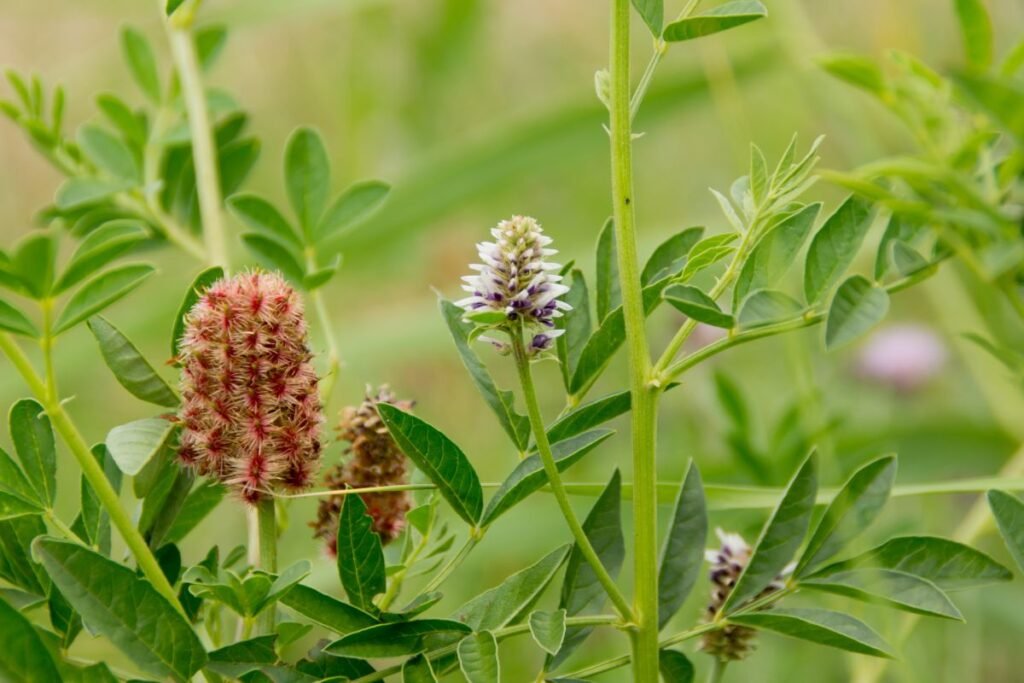
Licorice Root Tea Benefits
Licorice roots contain various chemical compounds and substances beneficial to the human body, including glycosides, glucose, sucrose, flavonoids, and more.
The primary active ingredient in licorice root is glycyrrhizin. This compound is responsible for the root’s sweet flavor, which is sweeter up to 50 times more than sucrose. Glycyrrhizin also contributes to licorice’s antioxidant, anti-inflammatory, and antimicrobial properties.
In addition, you may purchase various licorice root extract products, including capsules, powders, and tinctures. Licorice root gels are also used for external applications.
Currently, there is no universally recommended daily dose for licorice root. However, the World Health Organization (WHO) and the European Scientific Committee on Food (SCF) recommend limiting glycyrrhizin intake to 100 mg/day.
Benefits of Licorice Root Tea
Digestive Support: Traditionally, patients drink licorice root tea to support digestive functions, helping to soothe nausea and stomach discomfort. This tea can also alleviate gas and bloating. Studies have shown that regular consumption of licorice root extract helped eliminate H. pylori bacteria. This study suggests its antibacterial effects on the digestive system from harmful pathogens.
Antioxidant and Anti-Inflammatory Properties: Licorice tea contains antioxidants and compounds with anti-inflammatory effects, which help eliminate free radicals responsible for oxidative stress and premature aging. Research has indicated that extracts from licorice leaves and roots possess antimicrobial properties, which can help clear the skin and inhibit bacteria that cause inflammation.
Oral Health: Thanks to its antibacterial and antimicrobial properties, along with the presence of flavonoids and coumarins, licorice root tea may benefit oral health. It helps combat bacteria that cause plaque buildup and tooth decay.
Cold and Sore Throat Relief: Licorice root tea can also help with colds, sore throats, and coughs. The tea soothes the throat and supports the immune system, aiding the body in fighting off infections.
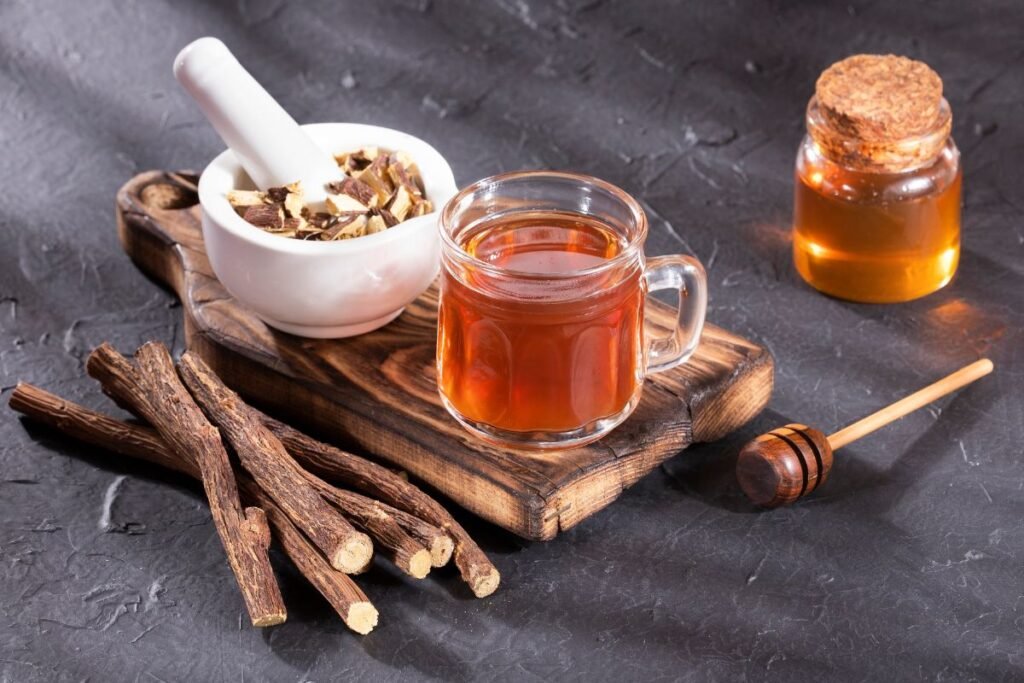
Licorice Root Tea Recipe
The simplest way to prepare licorice root tea is to steep the raw licorice root in boiling water.
Ingredients:
- 1 tablespoon of licorice root
- 300 ml of water
- Sweetener (optional, if you prefer a sweeter taste)
Instructions:
- Bring the water to a boil in a pot.
- Add the chopped licorice root (you can use a tea infuser to avoid straining the tea later).
- Switch off the heat and let it steep for about 10 minutes.
- Pour into cups and enjoy.
Egyptian Licorice Root Tea Latte
Try this exotic Egyptian licorice latte when you crave something sweet and soothing. This drink is a combination of licorice root tea and warming spices, enriched with almond milk, vanilla, and maple syrup. It’s a delightful beverage you can enjoy at any time of day.
Ingredients:
- ⅓ cup of hot water
- 1 tea bag or 1 teaspoon of finely chopped licorice root
- ¾ cup of almond milk
- ½ teaspoon of vanilla extract
- 1 teaspoon of maple syrup
- A pinch of ground cinnamon and a pinch of cardamom
Instructions:
- Steep the chopped licorice root in hot water for 7–10 minutes. If you use loose licorice root, strain the tea afterward.
- Heat the almond milk in a small pot over medium heat without bringing it to a boil.
- Remove the almond milk from the heat, add the remaining ingredients, and whisk for 30 seconds until thick foam forms.
- Pour the frothed almond milk mixture into the prepared licorice tea. You can sprinkle cinnamon on top or garnish with a cinnamon stick.
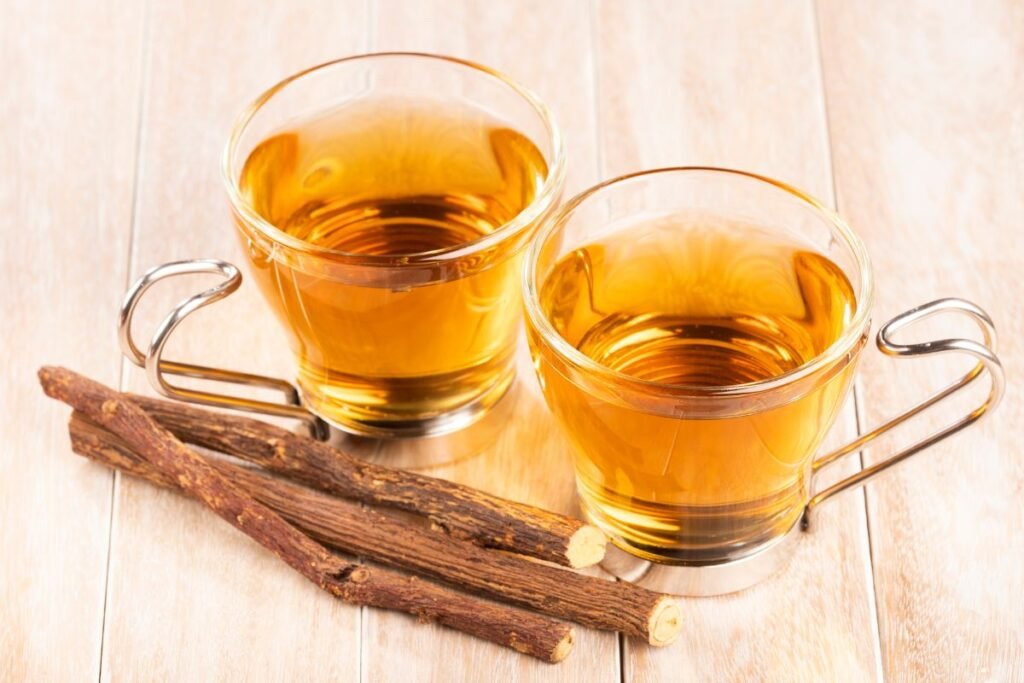
Licorice Roots in Cooking
The food industry widely uses licorice root as a product. They add it to soft drinks, candies, gummies, and more. Licorice is an ingredient in some alcoholic beverages. You may incorporate licorice root powder into various baked goods and ice creams. Additionally, licorice acts as an antioxidant and a spice in food fermentation processes, such as pickling cabbage or apples.
However, licorice has a distinctive flavor, often described as slightly reminiscent of cinnamon, with a pronounced woody undertone and a hint of bitterness. In many commercially produced food products, anise blends the licorice to balance its strong taste.
Due to its unique flavor profile, people typically love or dislike licorice, making it difficult to find a middle ground.
Licorice Root Syrup
Licorice root syrup, often enriched with vitamin C or anise, is commonly known as a medicinal product available in pharmacies.
We suggest a recipe for a licorice enthusiast—make syrup at home. You can use this syrup in various recipes to add a surprising twist to your dishes. You can drizzle it over ice cream, add it to cocktails or coffee, or pair it with meat or vegetable dishes.
Ingredients for licorice root syrup:
- 150 g of molasses sugar
- 15 g of licorice root powder
- 5 g of anise seeds (not star anise!)
- 5 g of fennel seeds
- 50 g of cane sugar
- 500 ml of water
- 30 ml of vodka
Instructions:
- Lightly toast the anise and fennel seeds in a dry pan, then brew them.
- Then, add molasses sugar, cane sugar, and licorice root powder.
- Stir everything well and bring to a boil.
- Remove the pot from heat and strain the liquid through a tea strainer.
- Pour the syrup into a clean bottle and add the vodka. That is it—your syrup is ready!
- Store the syrup in a tightly sealed bottle in the refrigerator.
The Benefits of Licorice Root for Skin Beauty
Incorporating licorice products into your skincare routine can offer numerous benefits. Licorice helps combat various skin issues, including premature aging, sun damage, and acne. It is suitable for all skin types to make many beauty treatments at home.
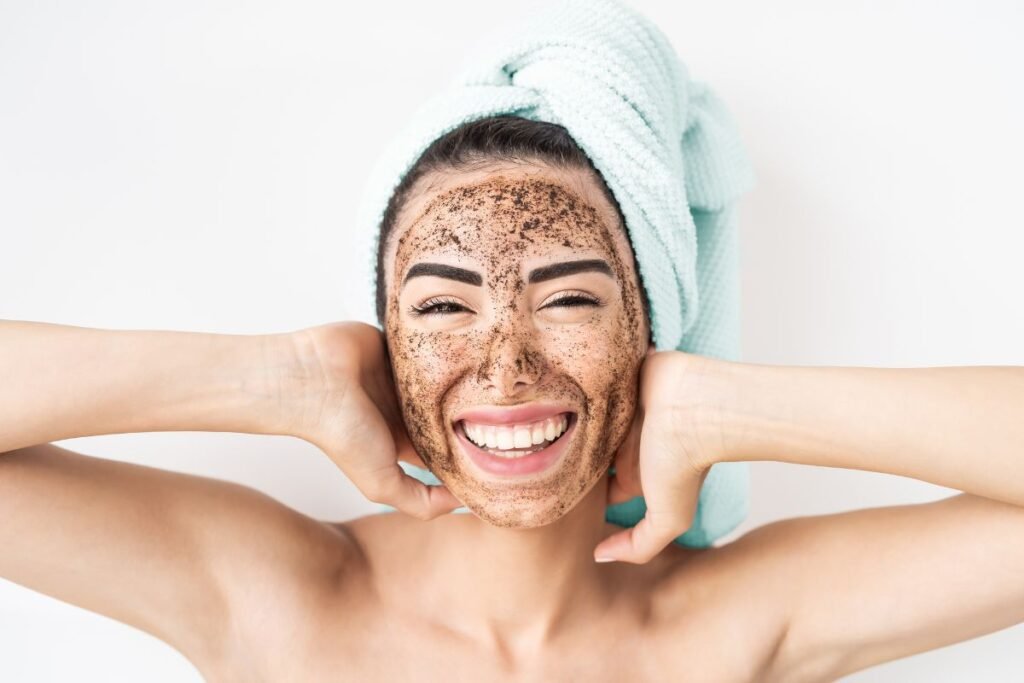
Licorice and Sandalwood Mask for Sensitive Skin
Sensitive skin is more prone to inflammation. Licorice helps address skin problems, while sandalwood provides a soothing effect.
Ingredients:
- one tablespoon of licorice root powder
- ½ tablespoon of sandalwood powder
- 2 tablespoons of cow milk
Instructions:
- Mix all the ingredients thoroughly until you achieve a smooth, consistent paste.
- Apply the mask generously to your face and leave it on for 15–20 minutes.
- Rinse off with cold water.
- Using this mask twice a week can yield noticeable results.
Citrus and Licorice Mask for Deep Facial Cleansing
Oranges and lemons are excellent for unclogging pores and removing excess oil, while licorice brightens the skin and gives it a healthy glow.
Ingredients:
- 1 tablespoon of ground orange peel
- one tablespoon of licorice root powder
- 1 tablespoon of lemon juice
Instructions:
- Mix all the ingredients thoroughly until you get a smooth paste.
- Apply the mask evenly to your face and leave it on for 5 minutes.
- As the mask starts to dry, gently massage your face to exfoliate, then leave it on for another 10 minutes.
- Rinse off with lukewarm water.
- You can use this facial mask two to three times a week for best results.
Aloe Vera and Licorice Mask for Skin Hydration
This hydrating mask combines aloe vera and licorice, having soothing properties and brightening effects. Apple cider vinegar helps balance the skin’s pH.
Ingredients:
- 1 tablespoon of aloe vera pulp
- one tablespoon of licorice root powder
- 1 tablespoon of apple cider vinegar
Instructions:
- Start by mixing the aloe vera pulp with the licorice root powder.
- Add the apple cider vinegar and stir well until you achieve a lump-free mixture.
- Apply the mask to your face and leave it on for 20–25 minutes.
- Rinse off with lukewarm water.
- You can apply this mask every 2 days to keep your skin soft and hydrated.
Honey and Licorice Mask for Skin Nourishment
Honey intensively nourishes and moisturizes the skin, while licorice helps brighten and even out the skin tone. A touch of lemon juice adds a refreshing boost.
Ingredients:
- 2 tablespoons of licorice root powder
- 1.5 tablespoons of honey
- 1 teaspoon of lemon juice
Instructions:
- First, mix the licorice root powder with honey until well combined.
- Add the lemon juice and stir until you get a smooth, even paste.
- Apply the mask to your face and leave it on for 25 minutes.
- Rinse off with cold water.
- Using this mask twice a week will give you noticeable improvements in skin texture and tone.
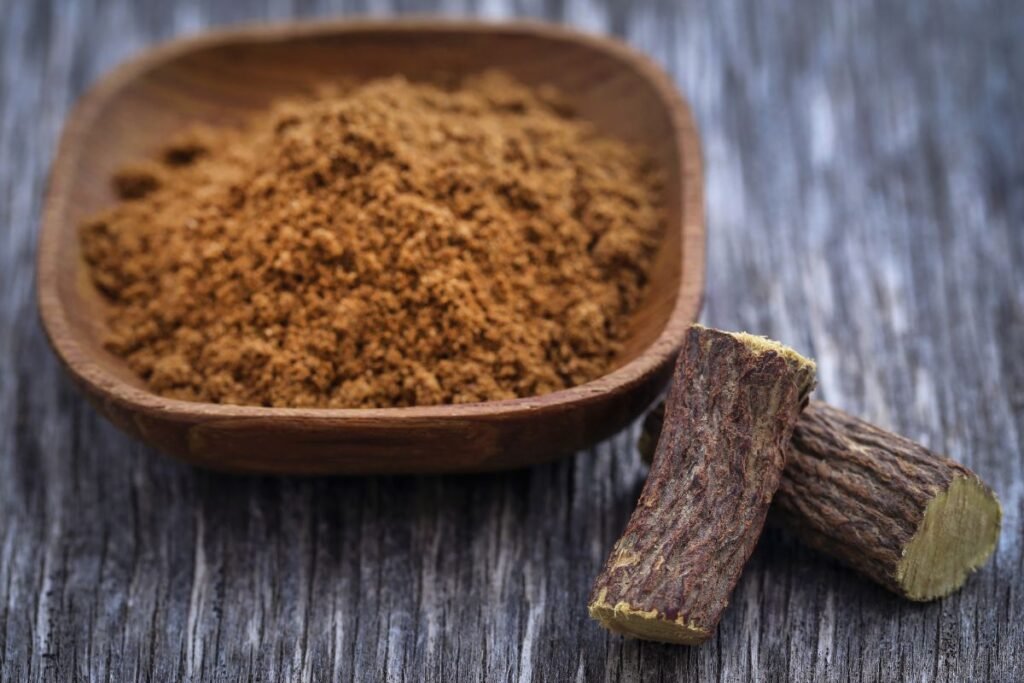
Side Effects of Licorice Root Tea
Licorice root tea is safe to consume when taken in moderation. However, long-term use or excessive consumption may cause side effects:
Pregnant women and those planning to conceive should avoid licorice tea. The high levels of glucocorticoids in it can increase the risk of mental disorders in babies and may lead to premature birth.
Licorice tea may interfere with the body’s absorption of potassium supplements. It can also cause adverse reactions when taken with medications that control blood pressure, diuretics, blood thinners, and hormonal medications, including contraceptive pills.
People with certain health conditions such as hypertension, diabetes, liver cirrhosis, cholestasis, edema, kidney failure, or heart arrhythmia should avoid this tea.
Excessive consumption of licorice tea can reduce testosterone levels, which may lead to men’s sexual dysfunction, decreased muscle mass, increased fatigue and body fat, and sleep disturbances.
Drinking large amounts of licorice tea can lower potassium levels in the body, leading to increased blood pressure, fatigue, and irregular heart function.
In any case, if you have chronic illnesses or are taking any medications, consult your healthcare provider before consuming licorice tea.
Uses of Licorice Root in Various Industries
- Tobacco industry
- Metallurgy
- Chemical industry (as a component in fire extinguishing mixtures).
- Textile industry (as a fabric dye).
- Fertilizer industry.
- Construction materials industry.
- Agriculture as an ingredient in animal feed production.
- Alcoholic beverage industry (for brewing beer and making anise-flavored liqueur like Sambuca).
Sources:
- https://www.ncbi.nlm.nih.gov/pmc/articles/PMC7122586/
- https://www.ncbi.nlm.nih.gov/pmc/articles/PMC3123991/
- https://www.sciencedirect.com/science/article/pii/S1413867016301696
- https://www.ncbi.nlm.nih.gov/pmc/articles/PMC3870067/
- https://academic.oup.com/aje/article/170/9/1137/165310
- https://academic.oup.com/aje/article/156/9/803/256317
- https://www.healthline.com/nutrition/licorice-root
- https://augustine-bar.de/2014/12/04/liquorice-syrup/
- https://www.dermaessentia.com/blogs/skin-care/licorice
Associative photos © Canva.
